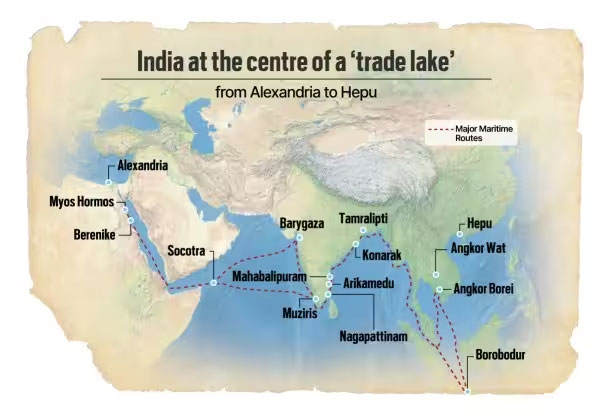Date : 26/09/2023
Relevance – GS Paper 1 – Art and Culture
Keywords – Lothal, Jataka tales, Sangam Literature, Maritime Trade Networks
Context
In November 2025, a remarkable 21-meter-long ship, constructed using an age-old technique of stitching together planks of wood with ropes, cords, coconut fibers, natural resins, and oils, will embark on a historic voyage from Odisha, India, to Bali, Indonesia. Manned by a crew from the Indian Navy, this project represents a significant initiative of the Government of India aimed at reviving the nation's rich maritime tradition and heritage. This endeavor sheds light on the legacy of Indians as seafarers and the remarkable boats or ships they employed for transcontinental trade voyages.
Early Maritime Trade Evidence:
The earliest known instance of people from the Indian subcontinent participating in sea trade dates back to around 3300-1300 BCE. Archaeological evidence from the Indus Valley, Mesopotamia, and other coastal sites along the Arabian Sea indicates the existence of maritime trade networks during this period. The dock at Lothal in present-day Gujarat stands as a remarkable testament to the Indus Valley civilization's deep understanding of tides and winds, showcasing their early maritime knowledge.
In addition to archaeological evidence, ancient texts provide insights into India's maritime history. The Vedas, composed between circa 1500-500 BCE, contain tales of seafaring and the associated perils. Buddhist fables, known as the Jataka Tales, and Tamil Sangam literature, composed between circa 300 BCE-300 CE, offer further references to seas and seafaring. Despite these hints and decades of scholarly research on India's maritime networks, the country's maritime heritage has often been overlooked in broader historical narratives.
Archaeologist PJ Cherian, who led the Pattanam (Muziris) excavations in Kerala, highlights that historians have frequently neglected India's maritime heritage due to biases favoring land-based histories. The development of land-based states and hierarchical polities has overshadowed the significance of waterbodies in India's historical narratives.
Evolution of Maritime Activity:
Early maritime activity in the Indian subcontinent primarily occurred along the coasts. However, by the 1st century BCE, the movement through the deep seas intensified, driven by the emergence of the Roman Empire and its demand for commodities from the East. The harnessing of monsoon winds played a crucial role in enabling mid-ocean crossings and facilitating transcontinental voyages, spurred by Roman commerce.
Ancient Indian Boats:
While evidence of ancient Indian boats is not extensive, some knowledge has been gleaned from extant boat-building traditions, as well as representations of seafaring vessels in art and literature. These traditions include the coir-sewn tradition of the Arabian Sea, the jong tradition of Southeast Asia, and the Austronesian tradition of outrigger boats. Notably, these traditions often employed stitching techniques instead of nails to join planks of wood.
Different types of wood were used for specific shipbuilding needs. For example, mangrove wood was valued for its sturdiness in making dowels, while teak was suitable for planks, keels, stem, and stern posts. Evidence of these traditions can be found in present-day coastal communities and archaeological sites across the Indian Ocean, from Berenike in the west to Java in the east.
India's Role in Maritime Trade Networks:
By the Common Era, the Indian Ocean had transformed into a bustling "trade lake," with India at its center. To the west, India was connected to Europe through the Middle East and Africa. The trade route linked Barygaza (present-day Bharuch) and Muziris to Red Sea ports in Egypt, such as Berenike and Myos Hormos. Ships would stop at various ports along the Arabian coastline for supplies and trade.
To the east, Indian artifacts have been discovered as far away as Hepu in China, dating back to the 3rd century BCE. The port of Tamralipti in present-day Bengal played a significant role in facilitating this trade. While exact numbers are challenging to ascertain, estimates suggest the scale of this trade was immense. Custom taxes on the Red Sea trade with India, Persia, and Ethiopia reportedly contributed a substantial portion of the Roman exchequer's income.
These maritime networks facilitated the movement of people from various backgrounds, allowing them to bring their cultures and ways of life to distant lands. In Berenike, for instance, artifacts of Indian origin or influence, including the Berenike Buddha, Hindu god reliefs, terracotta statuettes, and Sanskrit inscriptions, have been unearthed, showcasing the cultural exchange facilitated by trade.
Uncovering India's Maritime Past:
In recent years, excavations in sites across the Indian Ocean have provided valuable insights into India's maritime history. However, as Professor Steven Sidebotham notes, these efforts have only scratched the surface. Indian marine archaeology lags behind that of other regions, such as China or Singapore. The field of archaeology in India, in general, could benefit from increased funding and recognition. Many promising archaeological sites remain unexplored, representing untapped potential for uncovering India's rich past.
Conclusion:
In conclusion, India's maritime heritage is a treasure trove of history, culture, and trade that has often been overshadowed by land-based narratives. The revival of ancient shipbuilding techniques and the upcoming voyage from Odisha to Bali serve as a testament to India's enduring connection to the sea. As archaeological efforts continue to uncover the secrets of India's maritime past, the nation can reclaim its place in the world's maritime history and celebrate the seafaring legacy of its ancestors.
Probable Questions for UPSC Mains Examination
- How did early Indian seafaring activities contribute to the development of maritime trade networks in the Indian Ocean region, and what role did natural factors like monsoon winds play in facilitating transcontinental voyages? (10 marks, 150 words)
- What are the key factors that have historically led to the neglect of India's maritime heritage in historical narratives, and how can the recognition of this heritage contribute to a broader understanding of India's cultural and trade connections with the world? (15 marks, 250 words)







